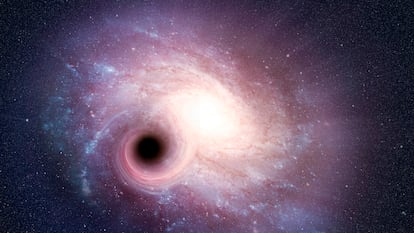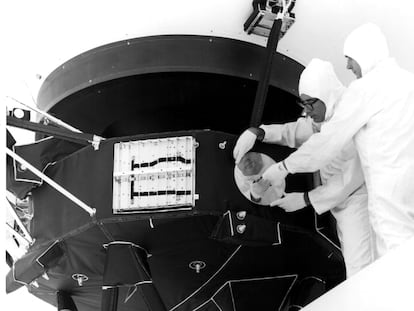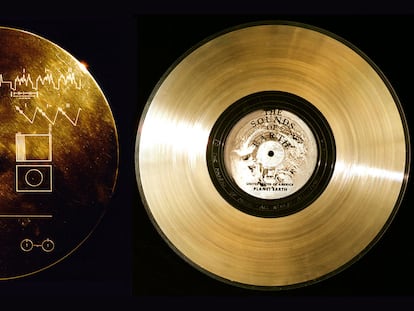The wormhole that changed a novel
One day in the spring of 1985, Carl Sagan telephoned his colleague Kip Thorne at his office in the Norman Bridge laboratory at Caltech in order to do research for the novel he was writing

The relationship between science and literature is as close as that of a window with the painting that covers it. You only have to take down the painting to realize that what is offered through the window is less interesting than the painting.
Something similar happens when we read a futuristic story and then go to look for the scientific source that inspired it. Because good science fiction authors do their own research to such an extent that there have been times when it has prompted new scientific studies. And that is what literature professor David Toomey tells us in his essay, The New Time Travelers, where he cites the case of the well-known astrophysicist Carl Sagan. One day In the spring of 1985, Sagan telephoned his colleague Kip Thorne at his office at Caltech’s Norman Bridge Laboratory in order to do research for the novel he was writing. It was to be Sagan’s first and only foray into fiction, since, as we know, throughout his life he wrote popular science books.
The novel was Contact and is about man’s first contact with an extraterrestrial culture. According to Thorne in his book Black Holes and Curved Time, the documentation that Sagan asked him for referred to gravitational physics and Thorne, delighted to be able to help his friend, read the manuscript carefully. So much so that he realized the mistake Sagan had made when presenting black holes as a means to travel through time. Because at first, Sagan had imagined that Dr. Eleanor “Ellie” Arroway would travel to the star Vega through a black hole. It was something shocking for the physicist Thorne, since Sagan proposed it as a round trip. However, once you enter a black hole, not only can you not return to the place of origin, but it is impossible to leave without being torn apart. For all these reasons, a black hole was not credible for the interstellar journey that Sagan proposed in his novel.
It was then that Thorne suggested that Sagan change the black hole for a wormhole, also known as the Einstein-Rosen bridge. The first quantum simulation of a wormhole opens a new door to understanding the universe, a kind of shortcut with two mouths, one for entry and one for exit. However, with this solution another problem arose, since the tunnel of a black hole tends to narrow until it closes completely. With this, a spaceship traveling through the hypothetical tunnel would be crushed. So, Thorne went further and found the key to keeping the tunnel open and devised a matter of negative energy that makes bodies repel each other gravitationally. By injecting the aforementioned exotic matter into the walls of the tunnel, the wormhole would never close.
And this is how the novel Contact was based on valid scientific hypotheses, and led Thorne to become involved in the novel in such a way that it inspired him to promote research on closed-time curves, which we will talk about in the next installment.
Sign up for our weekly newsletter to get more English-language news coverage from EL PAÍS USA Edition
Tu suscripción se está usando en otro dispositivo
¿Quieres añadir otro usuario a tu suscripción?
Si continúas leyendo en este dispositivo, no se podrá leer en el otro.
FlechaTu suscripción se está usando en otro dispositivo y solo puedes acceder a EL PAÍS desde un dispositivo a la vez.
Si quieres compartir tu cuenta, cambia tu suscripción a la modalidad Premium, así podrás añadir otro usuario. Cada uno accederá con su propia cuenta de email, lo que os permitirá personalizar vuestra experiencia en EL PAÍS.
¿Tienes una suscripción de empresa? Accede aquí para contratar más cuentas.
En el caso de no saber quién está usando tu cuenta, te recomendamos cambiar tu contraseña aquí.
Si decides continuar compartiendo tu cuenta, este mensaje se mostrará en tu dispositivo y en el de la otra persona que está usando tu cuenta de forma indefinida, afectando a tu experiencia de lectura. Puedes consultar aquí los términos y condiciones de la suscripción digital.
More information
Archived In
Últimas noticias
Most viewed
- Sinaloa Cartel war is taking its toll on Los Chapitos
- Oona Chaplin: ‘I told James Cameron that I was living in a treehouse and starting a permaculture project with a friend’
- Reinhard Genzel, Nobel laureate in physics: ‘One-minute videos will never give you the truth’
- Why the price of coffee has skyrocketed: from Brazilian plantations to specialty coffee houses
- Silver prices are going crazy: This is what’s fueling the rally











































